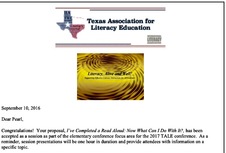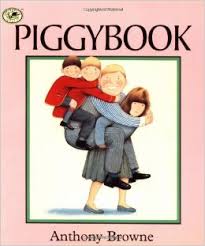 As I was beginning to prepare for my presentation on read alouds I found this book by Lester Laminack titled: "Unwrapping the Read Aloud: Making Every Read Aloud Intentional and Instructional". Laminack states that we should re-envision the read aloud as a means of instruction. (page 18) I take that even further and say, lets make the read aloud a good means to break away from out dependence on the Basel text we use in our classrooms. The read aloud can be a reliable means of supplementing the use of the Basel and keep the classroom a text rich place for students to learn a love for literature. To do this we must be intentional about how we choose, how we plan and prepare, and how we target specific skills when we conduct a read aloud. In his book Laminack mentions 11 read aloud experiences. He says that read alouds:
To make the read aloud intentional, we must plan, prep, read the book ahead of time, and consider the skills and concepts we want to teach when we choose a book. The author states that "we can make the read aloud intentional when we purposely select texts and times with the intent to inspire, invest, and instruct." (Laminack, 19) The right book can create a love of literature in children. It can lend itself to the perfect opportunity to develop key concepts in language, science, social studies, and math. It can even be used for instruction. If you plan effectively, students can learn exactly what you are expecting them to learn- being intentional is key- knowing our students and planning lessons that include read alouds that match targeted skills is just another way to optimize your instruction. Other than being expressive and full of energy when reading aloud you really don't need any special skills to do a read aloud. Start out with your favorite authors and illustrators and then move on to explore other authors and illustrators. It is also a good idea to explore other genres- for example postmodern picturebooks- and bring in the informational texts as read alouds. Just remember to read aloud often and well. Here is a list of good read alouds to get your started:
Some good ways to get started include, a picture walk, book talk, talking about the author, talking about the theme, or just start reading. According to Laminack,: "The tangible rewards of reading aloud and discussing books with children are both extensive and well grounded in research. Indeed, in 1985, the federally funded Commission on Reading released a report entitled Becoming a Nation of Readers and stated: the single most important activity for building the knowledge required for eventual success is reading aloud to children." (1985, p. 23) (page 94) Just keep reading, Experts tell us that students need to hear thousands of stories read aloud before they begin to read for themselves, some of that can happen at home-but may not- so, it is up to us to do in our classrooms as often as possible. Laminack, L. (2009). Unwrapping the read aloud. New York: Scholastic. Thank you for reading..
2 Comments
Today I am updating my blog from the Backwoods cabin in Broken Bow, Oklahoma -check out their website http://bluebeavercabins.com/ - I promise you will not be disappointed. This is a wonderful place to slow down and think. If you ever want to get away from the everyday stresses of life. Anyway, back to the topic at hand. Here is what I know, so far about professional writing:
I have learned a little about what it takes to be accepted into the professional world called "academia". I have learned that it is more than being well read, it is more than being smart, and it is more than just saying I went to this college and/or studied under that well-known person. It's a lot about how you get the information out about who you are, by speaking with and to professionals in the field you are in and about getting your ideas published in the right publications. The book I am reading now is titled: Writing for Peer Reviewed Journals: Strategies for Getting Published. In the book I have learned a little about how to choose with journals to even attempt to submit your writing to, It speaks of what is called your "Writer's Identify and of the discourse community to which you might belong. As a beginning writer I am finding tips that go deeper than the process of writing-which I find I still need- to the tips on what I need to do to not only get my name out there but to also get my words out their. I have made a step in establishing my identity as a part of "academia" by submitting a proposal to speak on an idea I have, now as I prepare that proposal I will write that up and use the ideas I have learned about in these books I am reading to get this idea published to share with a broader audience. This blog was my way to start that writing. I ideally just wanted to write and see how my writing progressed over time. I have noticed over time that I am becoming more confident and it is my hope that the audience that sees this writing becomes more defined as I grow and move into the "discourse community" -the group of like minded people who are experts in the same or relating fields of study-that I will become a part of. Thank you for reading... Feel free to leave me a comment. This week I received the news that my proposal to the 2017 TALE Conference (Texas Association for Literacy Education) was accepted. The conference is in Corpus Christi, Texas in February (2017). My proposal's topic is "I've Completed a Read Aloud: Now What Can I Do With It?". It will be an hour long session; other details will follow closer to the time for the conference. Now I have the work of gathering research to bring my presentation to life. It is very important to me to get this right and I am excited about this opportunity.
I will start with gathering more research and constructing an outline of what I want to cover. My basic idea is to show ways to teach comprehension, vocabulary, and fluency using books from different genres through read alouds. It is a best practice for a teacher to conduct read alouds in their classroom, I want to show some ways to maximize the read alouds they already do. I also want to expose them to other genres to read aloud to their students. The conference theme is: Literacy, Alive and Well: Supporting Effective literacy Interaction for All Learner; so, my research will contain some information to include read alouds that engage all learners. I will need to remember the strategies I've learned when working with adult learners to ensure that my presentation is engaging, informative, and fun. My presentation will need to be an hour in length; I want to have more information than necessary, in the case that my nerves get the best of me and I forget to pace myself. This is not my first time being a presenter - I do presentations for work often. It is the first time that I have proposed and created my own independent presentation. It is a part of my residency as a doctorate student; so, this is good practice. It is my first real professional gig. No, it's not something I will get paid for; I even have to register to attend the conference. It's the experience that I am looking forward to gaining. I do plan to use the same presentation for other conferences and opportunities this year. I even plan on attempting to present at a major national conference. Thanks for reading.  I have been exploring the genre of postmodern picture books for one of my courses(Learning to Read RDG 692). It's interesting because the genre is fairly new to me even though I am familiar with some of the stories and authors in the genre. What is most interesting to me about the genre is its nontraditional way of bringing the story to the audience. In fact, these stories encourages the reader to co-create the plot with the author. The characteristics of a postmodern picture book include:
Teachers may have more of a difficult time with this stories simply because they don't follow tradition and completing a simple "picture walk" through the postmodern picture book will certainly prove to be different indeed. Students, though will have no problem at all responding to these books and will enjoy how the characters speak directly to them. Here is a link to some of the more popular postmodern picture book authors and their stories:
Barone, D. & Mallette, M. Best practices in early literacy instruction. |
AuthorPearl Garden, Ed.D has completed her dissertation research involving understanding the vocabulary instruction practices of early grade teachers. She has a passion for the new and novice educator, and it is her goal to help educators tackle the achievement gap with her research findings. She will use this blog to share what she has learned in “pearls of literacy”. The ideas come from her dissertation titled “A Content Analysis of the Vocabulary Instruction Habits by Early Grade Teachers”. Archives
January 2024
Categories |



 RSS Feed
RSS Feed